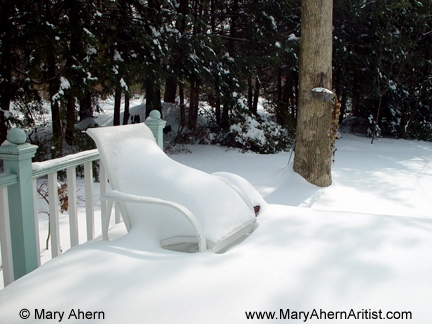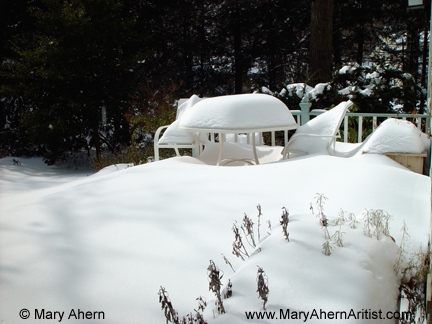For the past 25 years I’ve cultivated my woodland gardens. For the first decade I cleared the tangled woods, studied the indigenous plants, planned paths and materials. I worked on creating a natural looking shade garden focusing on the large oak trees and Kalmia that inhabited this spot of land before I showed up.
A lot of thinking and sweat went into this garden. I selected what shrub trees, like the untold numbers of small cherries, that needed to be removed. Purged, or shall I say, paid someone to purge the thick growths of poison ivy. Fought and pulled, yanked and grunted bales and bales of ivy from the trees and ground in a continuing war for dominance.
When the bones were clear I began to plant. The lists of shade tolerant shrubs and perennials read like a who’s who of my garden. Mistakes were made. Shade is not shade. Lessons learned. Successes were savored. Learning that gardening in shade reduces the need for weeding, plus you perspire less. Perfect!

Oak tree lost in battle with Hurricane Sandy
But Sandy decided she knew better and redesigned my garden. She blew in and knocked down three large oak trees and a beech thereby instantly transforming my beloved woodland shade garden into a sun-splashed mecca. Thousands of weeds instantly rejoiced by dancing in the new sunshine, prancing in the beds and mulched walkways. Ivy rebounded with a vengeance of superiority, eyeing triumph. Scores of broken and battered kalmia, enkianthus, leucothoe, rhodi’s, azaleas, viburnum, hammemelis, and andromeda wept.
And now?? Lessons begin again.
Looking for low-maintenance in the sunshine? Remembering our club trip to the Highline designed by Piet Oudorf, my Dutch hero, I’m creating new plant lists with sunshine in mind to cover the time for my new gingko to grow and spread. Shade my grandson will perhaps enjoy in case I miss it.
Amsonia, salvia, achillea, aster, coreopsis, Echinacea, eremurus, liriope, persicaria, rudbeckia, sedum, helianthus, and grasses, yes many textures and heights of grasses. I’m excited now that my period of mourning has passed. Excited by all the new possibilities in the sunshine.















































